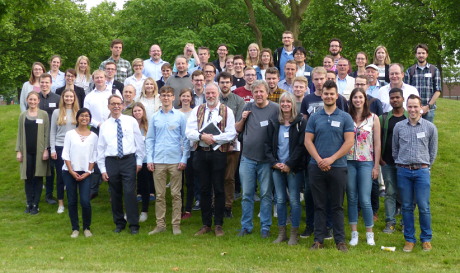About 80 scientists from 9 countries joined May 24-25 in Münster for discussing the progress in "Laser Bioimaging Mass Spectrometry".
The First Workshop on Laser Bioimaging Mass Spectrometry started with a short course on "Bioimaging Techniques" by Uwe Karst from the University of Münster (WWU). Uwe Karst gave an overview about complementary techniques for elemental and molecular bioimaging techniques and discussed their application by giving examples from the work of his group. The audience of about 50 participants especially appreciated the valuable hints for avoiding artefacts that may be produced when applying the wrong sample preparation for real complex samples.
The main workshop was opened after a lunch break by the organizers Uwe Karst and Michael Sperling.
Michael Sperling than chaired the first session that was ment to give an overview over the methodology and applications of bioimaging. Brian Jackson (Dartmouth College, Hanover, USA) gave an overview about environmental and biological applications, while Oliver Hachmöller (BASF, Germany) discussed industrial needs for elemental bioimaging. Elias Lützen (WWU) enlarged the application field by discussing a forensic application related to the formulation of drugs. Dhinesh Asogan (Thermo Scientific, Bremen, Germany) highlighted the advantages of using a triple quad ICP-MS as detection system for laser ablation. Special possibilities for quantifying elemental maps by isotope dilution analysis were presented by Bolle Bauer (WWU).

Photo: Part of the Workshop participants
The second afternoon session chaired by Norbert Jakubowski was continuing in discussing interesting applications for bioimaging. Jörg Feldmann (University of Aberdeen, UK) discussed the distribution of mercury and selenium in the brain of whales and iron and zinc in different tissues. His main message was that together with MALDI, LA-ICP-MS can provide useful information to study metal<>protein interactions. Together with pathology, the information provided can help to differentiate between healthy and diseased states. Even further, with the help of isotope tracers, accumulation processes and their kinetics can be studied. Tanja Berg (WWU) discussed the fate of tattoo inks in the skin and their translocation to other organs. Katharina Halbach (Helmholtz Leipzig, Germany) discussed the "Uptake and Transformation of the AChE Inhibitor Naled in the Zebrafish Embryo". Lukas Schlatt (WWU) presented the distribution of platinum in the bone of a mouse treated with a chemotherapeutics.
Martin Rittner (Tofwerk, Thun, Switzerland) discussed the enhanced possibilities of ICP-TOF-MS as detection system for laser ablation. Estephany Marillo-Sialer (University of Melbourne, Australia) showed how X-ray tomography can help to generate 3-D Distribution Maps from LA-ICP-MS Elemental Maps. Valerie Brückel (WWU) finished the session with her contribution discussing the "Coupling of Laser Ablation with halo-Flowing Atmospheric-Pressure Afterglow-Mass Spectrometry as a New Molecular Imaging Technique"
A long day packed with interesting presentations found its end with a barbecue that gave ample time to interact with colleagues.
The next day started with the morning session chaired by Uwe Karst. The first speaker was Philip Doble (Sydney University of Technology, Australia) who presented the application of LA-ICP-MS for "Personalising Cancer Radiation Treatment". After introducing medical applications, Stefanie Fingerhut (WWU) discussed the retention of Gadolinium in the brain of patients having received Gd-based contrast agents. Adam Sajnog (University of Poznan, Poland) presented "Quantitative Mapping of Ti, Al and V Released from Dental Implants in Oral Mucosa by LA-ICP-MS". The session ended with a contribution by Jennifer-Christin Müller (WWU), discussing "New Therapies for the Treatment of Wilson's Disease".
The second morning session after a coffee break was chaired by Philip Doble. The first presenter in this session was Ralf Weiskirchen (University Hospital Aachen, Germany) who gave an overview over "Application of Laser Ablation Inductively Coupled Plasma Mass Spectrometry (LA-ICP-MS) in Experimental and Clinical Metal Dysbalance". He was followed by Heike Traub (BAM, Berlin), who discussed the Nanoparticle-Cell Interactions. Sabrina Kröger (WWU) explained how Multimodal Imaging was used to investigate Both diagnosis as well as therapy approaches for Glioblastoma. The session was completed by Ann-Christin Niehoff (Shimadzu, Germany) who showed the value of complementary bioimaging for the determination of nanoparticles in the lung and their toxic activity.
The lunch break was prolonged to provide time for visiting the posters again or for visiting the exhibitors, who were fully integrated into the scientific programme.
The last session of the workshop was chaired by Jörg Feldmann (University of Aberdeen, UK). The first contribution entitled: "Quantification of Implant Components in Animal Tissues" was presented by Julia Bode (TU Bergakedimie Freiberg, Germany). Rebecca Buchholz (WWU) than demonstrated the possibilities of LA-ICP-MS for the " Specific Quantification and Biodistribution Analysis of 57Fe-enriched Iron Oxide Nanoparticles". David Clases (Sydney University of Technology, Australia) presented an approach for single analyte detection system tuning and quantitative bioimaging by means of immunohistochemical methods. Robin Schmid (WWU) presented a new imaging software for visualisation of single particle analysis in tissues. The last presentation in this session and the whole workshop was given by Norbert Jakubowski (BAM, Berlin).
The team of local organizers (Uwe Karst, Michael Sperling and Martin Vogel) closed the workshop not without announcing already the next issue. A farewell reception was used to discuss open questions and to wish a safe home return for everybody.
 Related EVISA Resources
Related EVISA Resources
 Related EVISA News
Related EVISA News
last time modified: September 22, 2024